Stabilizers are used on ocean-going vessels to remove the discomfort of ocean swell. Generically they come in two broad forms, passive and active. Passive stabilizers are the metal fins that you might have seen hanging from outriggers on fishing trawlers. And, if you saw the movie The Perfect Storm, that was a passive stabilizer that came through the pilothouse window. On Dirona, we have active stabilizers. In our case it’s effectively a wing on each side of the boat that is hydraulically-driven.
One of the biggest concerns when we bought Dirona were stabilizer failures. When they happen, owners aren’t happy and it ends up being widely reported. I think in retrospect our concern was misplaced. Faults really aren’t very common. In the 7,518 hours we have wound onto Dirona, we have never been at sea with the stabilization system inoperative. We have operated on a single fin in the past but it’s amazing how well the system performs on just one fin.
There are several wear items in our ABT stabilizers where periodic maintenance is required. One is the actuator, where the recommended replacement interval is 2,000 hours. During our trip from St. Helena to Barbados, our port fin actuator started to leak hydraulic oil. I hate a mess, so I just shut off that fin. Sea conditions were calm enough that shutting off one fin made no difference at all. However, the weather conditions predicted for the last week of the trip have been looking poor so why not just change the actuator? I’m not in love with the idea of working beside a running main engine in a 112F engine room. But, everything I fix at sea frees up time to have fun on shore and, with rough water coming, it would be nice to have to have both stabilizers swinging. I can change actuators fairly quickly, so it’s really not a big deal.
The actuator, pictured at the top of this post, is the hydraulic cylinder that extends and contracts to swing the fin back and forth. I’ve always got spares on board since the replacement period is only 2,000 hours. The replacement procedure is fairly simple, but it’s a bit more involved when changing it underway.
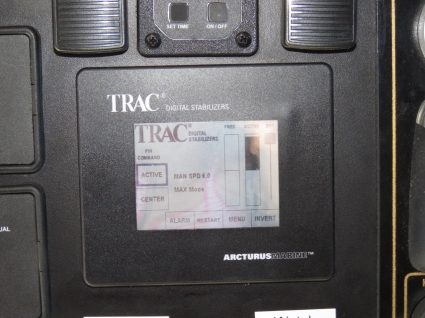
|
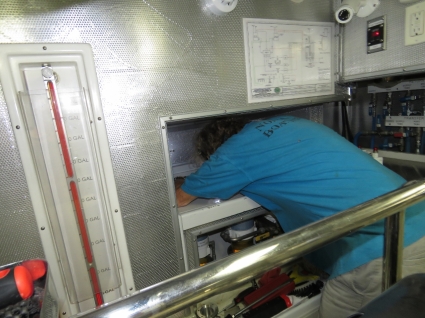
|
To keep things comfortable I did most of the work with the starboard fin still running. I first removed the delicate fin position sensor and, once that was out of the way, I removed the 6 large allen screws that hold the top casting in place (first picture below). It lifts off to reveal the actuator (partly visible at bottom left of first picture below). Then I removed the clevis pin and lifted out the cylinder with the hydraulic lines still connected. I then installed the new part and put everything back together except 1) the hydraulic lines were still hooked up to the old actuator and 2) I’ve not yet installed the fin position sensor.
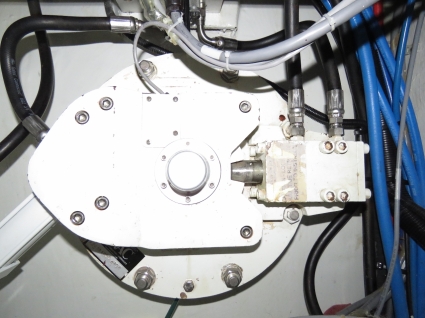
|
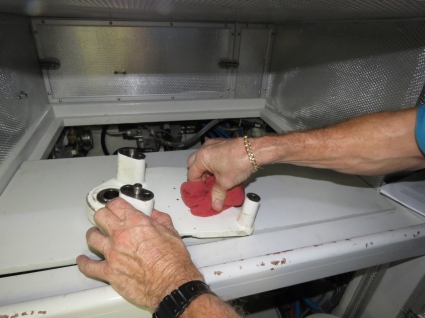
|
At this point, we needed a few minutes without hydraulic pressure. Technically the pressure on a depowered fin is only hydraulic idle pressure and so, if you were willing to make a big mess, it probably could be switched under pressure. But, it’s not really worth it. You only need to get the pressure off for 2 minutes to switch the hoses. We changed course to run down-wind, started up the wing, and shut down the main. The boat was fine running on the wing on autopilot.
Why not just shut off the hydraulic pressure rather than shutting down the main engine? You can shut off the hydraulic pressure but the main pump is live which means there is no clutch (the wing has a clutch to disengage it) so there is always at least idle pressure when the main engine is running.
By shutting down the main, we enabled an easy, fast, and clean change with no pressure in the system. Less than 2 minutes later, the hydraulic oil lines were on the new actuator, the main was restarted and the wing was shut back down. We continued to steer down-wind without stabilization while I adjusted the fin center position. It may be possible to adjust the port-side fin sensor with the starboard fin running, but I wasn’t sure, so I left the stabilizers off for this procedure. It took about 15 minutes to adjust the fin center position, at which point the system was ready to run.
We put both fins back on, returned to our original course, and I finished putting the covers on and cleaning everything up while enjoying both fins swinging. If you look closely, you’ll see the short little diversion when we made the change.
That is all there is to it. Both fins were running and I jumped in the shower to recover from having sweated out about a gallon.
Port Fin in Trouble
We have changed stabilizer actuators several times and, as described above, it’s both an easy and not particularly error-prone process. So about 15 hours after I’d changed the actuator, I’m sure Jennifer was surprised during her watch to hear an alarm and see a “port fin in trouble” message, with both the stabilizers shut down. Jennifer elected to clear the message and restart the stabilizers on the single starboard fin rather than wake me up. Way to go Jennifer!
By the way, corporate error messages are a pet peeve of mine. In order to avoid “confusing their users” many companies make it just about impossible to figure out what is going on. I love the clear and concise ABT error.

|
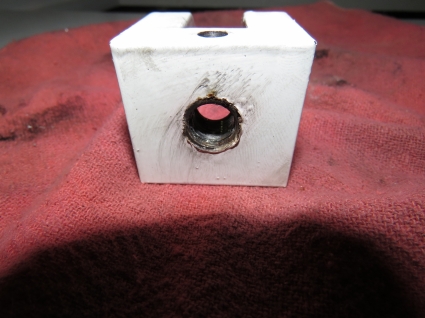
|
I had a look at it in the morning and the actuator appeared to have simply come apart. The clevis had unscrewed and fallen off. On closer inspection, we just got unlucky and the actuator clevis set screw was missing on the new part we had just installed. And, without that 1/8″ set screw, the system spent the next 15 hours first unscrewing and then damaging the actuator.
But, no damage was done beyond destroying the new actuator. I put on my last spare and we were back up and running. I reported the issue to ABT who, while so many companies I work with would say you bought that spare four years ago so the warranty has long since expired, said “no problem” and asked for pictures to help chase down the issue. That’s one of the reasons I like ABT so much. They build an exceptional product and stand behind it so you’re never stuck with unanswered questions.


Well done as usual.
Did you change the main engine oil at the same time or was this a second main engine shut down?
The stabilizer leak showed up later, so it was a seperate main engine off/on cycle. You just don’t have much choice with a live hydraulic pump — if you want pressure out of the system to open hoses, the main has to be off. Making it a bit worse we intsalled a faulty part so needed to do it again the next day :-).
So we have gone from being really uncomfortable shutting the engine down to doing it every second day or it seems a bit like that.
You might as well just park up and have a swim while you’re at it!